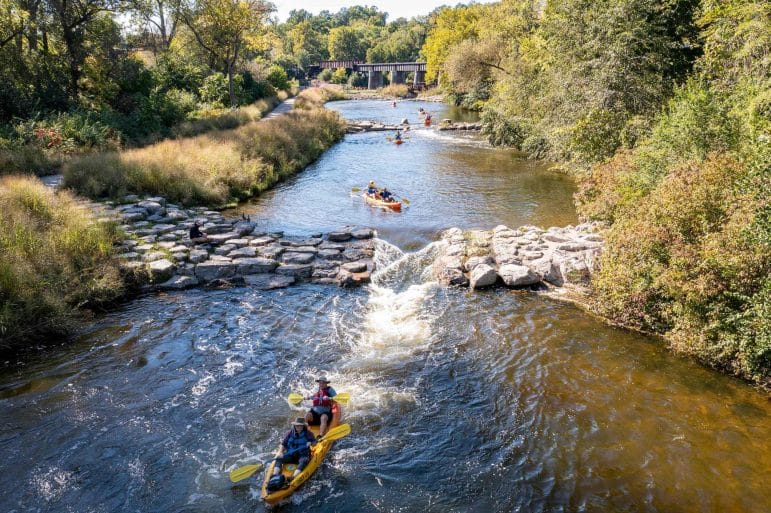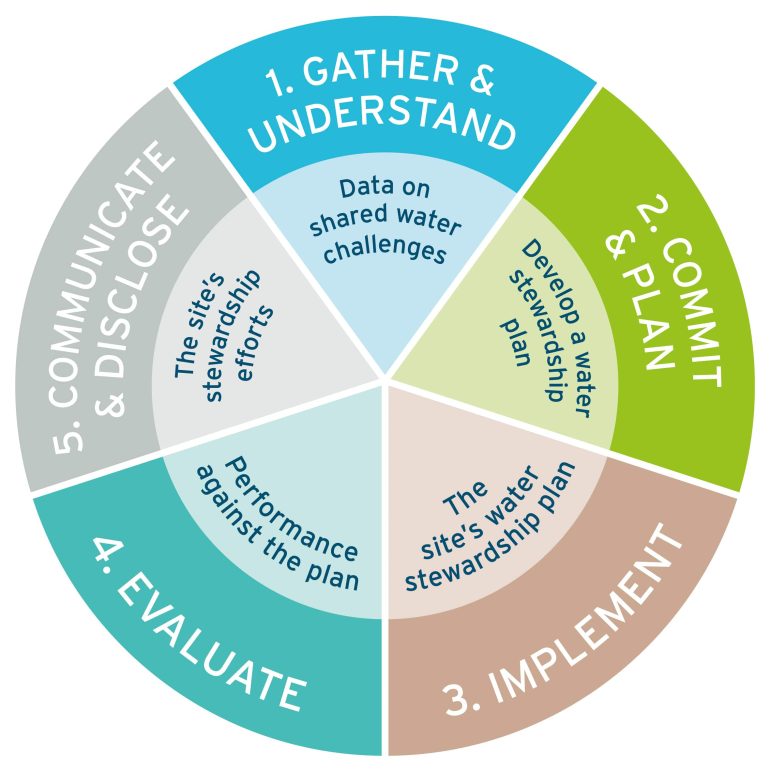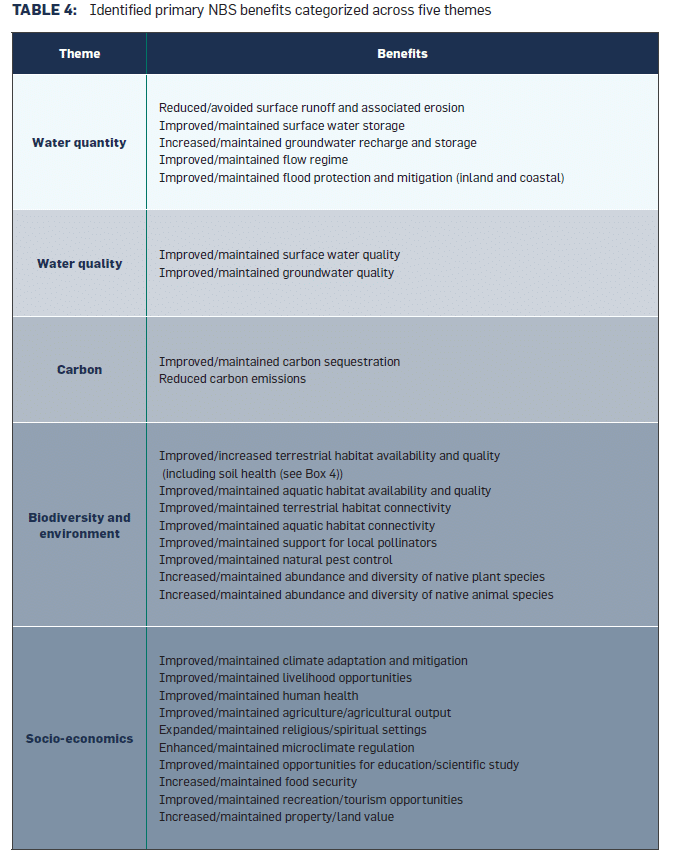
Supporting the Implementation of Nature-Based Solutions
As sites implement the AWS Standard and look outside their fence line, nature-based solutions (NBS) should be included in the ‘toolbox’ of actions to improve water stewardship.
By Penelope Moskus, Senior Environmental Scientist (Ann Arbor, MI) and Ben Roush, Environmental Scientist (Ann Arbor, MI)
April 14, 2023
Land conversion, pollution, and unsustainable water use have affected the environment and communities in many ways. These stressors impact the ability of watersheds to regulate flow and contribute to deteriorated water quality, reduced carbon sequestration, and declining biodiversity and watershed health. Extreme events such as the 22-year megadrought in the western US, the 2022 flooding in Pakistan, and the 2023 re-emergence of Tulare Lake in the central valley of California are a few examples where climate change has further exacerbated the impact of existing stressors on communities, farmers, and businesses.
Unsurprisingly, climate change resiliency and the need for collaboration to solve these big problems were common themes at the 2023 United Nations Water Conference. For example, to respond to flooding from sea level rise and intense storms, New York City, Copenhagen, and Rotterdam came together at the conference to share how they exchange information on best practices, some of which include nature-based solutions. As sites implement the Alliance for Water Stewardship (AWS) Standard and look outside their fence line, nature-based solutions (NBS) should be included in the ‘toolbox’ of actions to improve water stewardship. As described below, the multi-benefits of NBS align closely with several AWS outcomes.

What are Nature-based solutions?
NBS are actions to protect, sustainably manage and restore natural or modified ecosystems that address societal challenges effectively and adaptively, simultaneously providing human well-being and biodiversity benefits (adopted from IUCN, 2016). Examples of NBS include using wetlands for stormwater or wastewater treatment, using mangroves to reduce wave action along coastal areas, or implementing regenerative agriculture.
Regenerative agriculture is an evolution of conventional agriculture, reducing water use and other inputs (e.g., herbicides, pesticides, fungicides, etc.) and preventing land degradation and deforestation. Regenerative agriculture protects and improves soil and biodiversity, climate resilience, and water resources while making farming more productive and profitable.
What are the benefits of implementing NBS?
NBS are an important companion and often an alternative to ‘grey infrastructure’ and are increasingly recognized as an effective means of achieving multiple benefits. NBS’ frequently cost less to implement than traditional ‘grey infrastructure’ solutions. Moreover, investments in NBS can deliver sustainable improvements in watershed health with multiple benefits, including water, carbon, climate resilience, and biodiversity for the environment, along with social, cultural, and economic benefits for communities.

How do I learn more?
Identifying and accounting for multiple benefits can help build the case for investments in NBS for watersheds. The free web-based NBS Benefits Explorer tool was developed through a collaboration between the CEO Water Mandate, Pacific Institute, The Nature Conservancy, Danone, and LimnoTech and can support the planning, implementation, and assessment of NBS activities. For example, the NBS Benefits Explorer shows that protecting an important water-related area (IWRA), such as a wetland, would provide many geomorphic, hydrologic, flow regime, water quality, carbon sequestration, habitat, and social benefits.
The US Army Corps of Engineers (USACE) Engineering With Nature (EWN) Program and the Network for Engineering with Nature (N-EWN) are other useful resources for NBS. The USACE EWN program was established in 2010 to enable more sustainable delivery of economic, social, and environmental benefits associated with infrastructure. N-EWN, established in 2019, is an active community of researchers, practitioners, and educators who are addressing the major infrastructure challenges facing our society while creating opportunities that align ecological, social, and engineering processes to achieve multiple societal benefits. LimnoTech supports both the EWN and N-EWN programs through programmatic support to scale up partnerships, education, research, and implementation of NBS. Tools and resources to support the implementation of NBS can be found on the N-EWN and EWN websites, including NBS project examples, modeling tools, webinars, and other educational materials, current research publications, and guidance documents.
NBS are an effective means to drive water stewardship, support climate resiliency, and achieve multiple benefits aligned with environmental and societal needs. By working in conjunction with conventional engineered solutions, implementing NBS contributes to the AWS outcomes of good water governance, sustainable water balance, good water quality status, important water-related areas, and safe water, sanitation and hygiene for all (WASH). The resources previously mentioned, in combination with examples of successful nature-based solutions for agriculture and climate, can support the selection of NBS. Other NBS examples can be explored on the EWN Proving Grounds web page, where USACE districts and divisions share the integration of EWN principles and practices into all business lines in the form of constructed projects. The proving grounds are places where innovative ideas are tested on the ground with processes documented, project milestones noted, and lessons learned are shared in the implementation of EWN measures so others can learn from their experience (USACE EWN).
If you want to discuss your water stewardship or AWS Standard implementation needs, please get in touch with Penelope Moskus at pmoskus@limno.com.
This article is the eighth in a series of articles authored by LimnoTech staff on water stewardship. Follow us on LinkedIn or Twitter (@LimnoTech), and check our website’s Insights & Perspectives page for more information and updates.
Links to the other water stewardship articles in this series are provided below:
The Alliance for Water Stewardship Standard – Framing a Decade of Water Stewardship
Understanding and Engaging Water-Related Stakeholders
Assessing Water-Related Risk As A Foundation For Stewardship
Success Strategies for Developing a Site Water Stewardship Plan within the AWS Standard Framework
Strong Site Teams Lead To Successful Water Stewardship
Penelope Moskus is a Senior Environmental Scientist and Project Manager with over two decades of experience. She supports LimnoTech’s water sustainability consulting services, helping clients develop strategies, guidance, and tools to reduce water-related risks. For over a decade, she has evaluated volumetric and complementary benefits of potential and funded projects and annually supports companies with their annual reporting. She has supported the replenishment program of a major food and beverage company for over a decade, including programmatic support, volumetric benefit quantification, reporting, verification, and tool development. She provides similar services for a wide range of clients, including global and local NGOs, food and beverage companies, energy providers, high-tech companies, agricultural providers, and a national supermarket chain. Penelope is an accredited consultant for the AWS International Water Stewardship Standard and contributed to a landmark paper on Volumetric Water Benefit Accounting.
Ben Roush joined LimnoTech in April 2022 as an Environmental Scientist. Ben has worked in water resources and environmental sciences for eight years and in environmental consulting since 2019. His primary responsibilities include supporting clients with corporate water stewardship and risk assessment. Ben has experience working in both the non-profit and government sectors. His background and expertise include watershed modeling, stakeholder engagement, watershed assessment, surface and groundwater monitoring, and soil/groundwater remediation. Ben has a Master of Science degree in Natural Resources Science and Management focusing on Forest Hydrology and Watershed Management from the University of Minnesota and a Bachelor of Science degree in Geography from Western Michigan University.
The content herein is the author’s opinion and not published on behalf of the Alliance for Water Stewardship (AWS). The author holds an AWS Professional Credential and this piece of publishing helps fulfill their Continuing Contribution Units requirements. For more information about AWS or the AWS Professional Credentialing Program please visit https://a4ws.org/.




